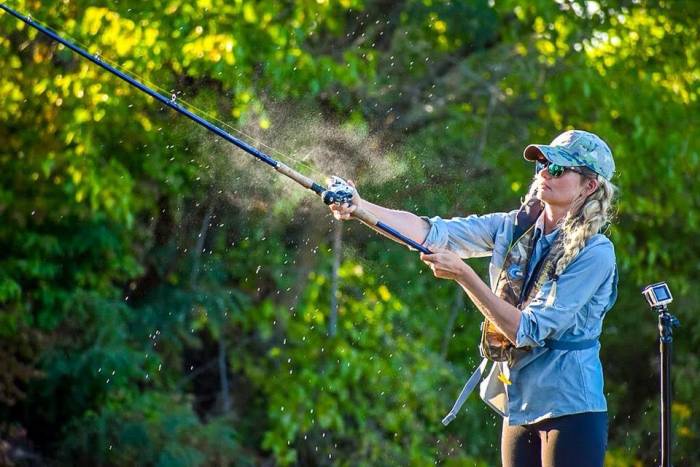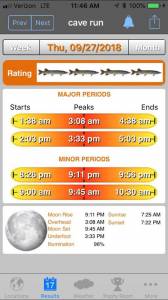Fall is the perfect time to catch the fish of 10,000 casts. Professional angler Kristine Fischer shares the beta on her tried and true musky tactics. Here’s how to make it less than 10,000.
September graces the nation with cool mornings and fall hues. The majority of people flood football stadiums and Starbucks drive-thrus whereas outdoors-lovers eagerly climb into deer stands or take refuge in duck blinds.

This provides fall solitude on the water for a select type of outdoor enthusiast, the musky angler. And there’s no better time to be on the water in pursuit of these elusive fish than in autumn.
Fall Musky Fishing: Up for the Challenge?
Musky fishing is not for the faint of heart. Living up to their reputation “the fish of 10,000 casts,” muskellunge have the ability to not only physically defeat an angler but mentally push one past his or her limits.
Anglers across the country log countless hours all season often going days without so much as seeing a fish. However, these fish rely heavily on feeding to sustain energy before temperatures plummet and ice stakes a claim on these waters.
Thus, fall can put anglers at an advantage to catch the fish of a lifetime.

Here’s the where, when and how tips to increase your chances of successfully locating and landing a monster musky.
Where to Catch Fall Muskys
Understanding how these fish transition from late summer to fall is key in helping you locate them. This section will zero in on three location-specific areas to funnel your efforts.
Remaining Foliage
Most areas of the country experience a semi to full weed kill as the water cools off. Finding areas of the river or lake that hold any remaining healthy and highly oxygenated weed growth can be crucial in finding fall musky.
Often times deeper weed beds have a better chance of maintaining live foliage. With the use of electronics, particularly side scan, one is able to quickly search bays and deep flats for remaining weed beds.
Without electronics, you can simply visit areas of the lake that produced vegetation in the spring and summer. Allow your bait to retrieve samples of the grass to determine whether or not it is leafy and green, or in the last stages of life.
You can quickly eliminate areas where vegetation is dying off. Focus on productive areas that contain good vegetation.
Main Lake Structure and Points
More key areas for fall musky include rock and brush piles. Rock piles and reefs tend to retain heat during the cooler months, which in turn attracts a variety of aquatic life.
Brush piles also offer ambush points and attract smaller bait fish, making them ideal for fish looking to take advantage of narrowing windows to feed. Musky will also gravitate towards points, submerged islands and other shallow water in search of warmer temps and prey.
Bait Schools
Baitfish tend to gather in large schools as the season moves on. This creates a non-stop dinner bell for the lakes predators.
Using what is listed above, you can conclude that baitfish tend to be found suspending over main lake structure or humps, off of points, or around oxygen producing foliage.
Use your electronics to locate giant bait schools, or watch the lake for signs of active bait just below the surface. Learning the depth of the bait schools is important for understanding where to present your bait in the water column, as musky generally feed on the side or below.
When to Catch Muskies
It is no secret that in order to be successful in the world of musky fishing, one needs to be willing to devote a substantial amount of time on the water.

Yes, fishing sun up to sun down will increase your chances on putting a fish in the boat, but knowing what times of the day to be at your most productive areas can exponentially increase your odds of hooking one.
Sunrise/Sunset
First and last light often provides anglers a window of opportunity to target muskies. In the crisp, early hours of fall mornings, baitfish tend to move shallow. The big fish follow.
Low light conditions mixed with active baitfish allows for excellent topwater fishing.
As the sun begins its descent, fish begin to feed and move back into areas where they are susceptible.
Moonrise/Moonset & Underfoot/Overhead

Much like the sun, the moon also has a “rise” and a “set”. This has a gravitational pull on the bite and can trigger feeding.
Knowing your moon set and moon rise, as well as when the moon is overhead or underfoot, gives you an idea of when your feeding windows are likely to occur.
When a moon set or moon rise lines up with first or last light, we call it the magic hour. Using apps like ISOLUNAR ($.99 a month) provides anglers the exact times of these phases. You can be sure you’re in an area with active fish when they’re likely to double your rod over.
New Moon/Full Moon
There has been a “full moon” buzz regarding fishing for decades. Many anglers plan hours on the water when the moon is full. Armed with big blades, buzz baits, walking baits or anything that causes a commotion in hopes of luring a lurking giant.
The new moon isn’t something you want to sleep on. Many respected musky anglers have logged as much if not more activity during this moon phases.
How to Catch Autumn Muskies
These fish feel the pressure to feed when the water temps start dropping. The fall is that time of year when fish chase bait up rivers and up the backs of creeks to capitalize on these feeding opportunities.

There is no better time to break out the big baits.
Big Baits = Big Fish
One of the draws to musky fishing is no doubt the tackle. A first-time musky angler can get lost in tackle shops such as Crashes Landing, browsing aisles of wild baits, many weighing in at over a pound.
The fall is an excellent time to gain confidence in throwing these big baits. Muskies look to capitalize on large meals that take minimal effort. A larger presentation means more water displacement and more “noise.” These baits captivate the musky’s attention.

Jerkbaits
A fall necessity, jerk baits emulate a dying baitfish. They are making them a deadly weapon to add to your fall arsenal. Since musky will generally hit these baits on the pause, it is important to be prepared during the entire retrieve.
Several different brands allow you to add weights to the bottom of the baits to keep it in the strike zone longer. Some of the more popular jerk baits include the Triple D ($20.99-$34.99), HellHound ($18.99-32.99), and Xorsist ($59.99)
Big Plastics
Versatile and effective, these big plastics put muskies in the boat year round. These baits offer a more “life-like” presentation to them than their hard bait relatives.
In the fall, you can let soft plastics sink down to the bottom then erratically work them back by popping, jerking, or swimming them to the boat. Essentially, these baits can be used as a crankbait or a jerk bait.
My go-to soft plastics are the Chaos Medussa ($15.95-32.95) and the Bulldawg $26.99.
Crankbaits
Likely the best way to cover water and entice a strike, crankbaits are an excellent bait to work along the rock and other structure. Trolling cranks is one of the faster ways to cover water. But you sacrifice being able to pick apart the structure.
By casting, you can aggressively bump cranks along the rocks or against laydowns to appeal to a large fish waiting to ambush. Match your crank to the depth you’re aiming to target.
My favorite cranks are the LLUNGEN 22 short ($21.99-25.99) for a smaller profile, and the all-new LLUNGEN 22 long series ($24.99-$29.99), and the Thorne Bros Boss Shad ($26.99-$59.99).
Put in the Time to Catch Muskellunge
Patience and persistence are key. The more you put into this sport, the more you will be rewarded. Let the fish tell you what they want, and how they want it, as this can change by the hour.
Notice your surroundings and pay attention to what the forage is doing. Slow your roll, as muskies’ metabolism slows as the days grow shorter. When you raise a fish that doesn’t commit, come back to the same area during a peak time and work the fish again.

Fall can make or break you.
Casting big baits as ice builds in your guides and daylight fades into night is taxing. It is enough to make the average person give up. But all it takes is one fish to change your disposition, and hook you for a lifetime.
The post Fall Musky Fishing: The Tips You Need appeared first on GearJunkie.
from GearJunkie https://ift.tt/2Ik1ReJ
https://ift.tt/2OgInx4

No comments:
Post a Comment